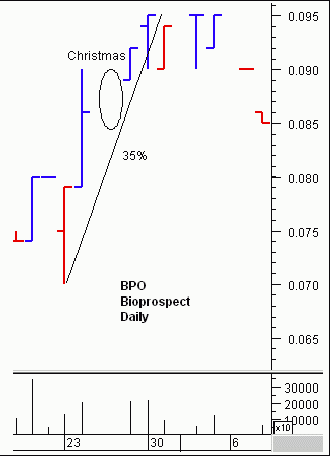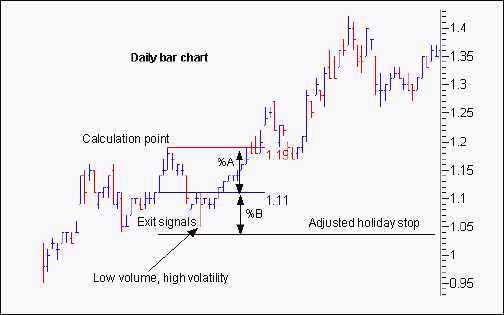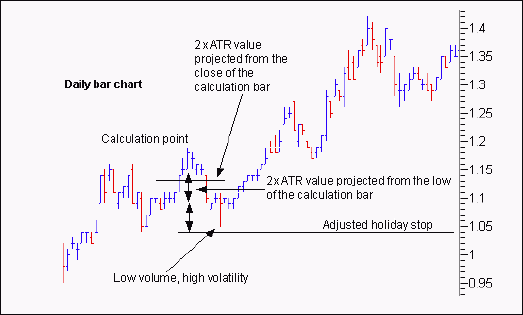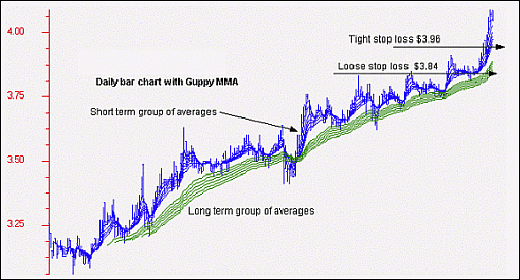- China Trading Statistics
- Darvas Trading
- GMMA Breakout Behaviour
- Happy Easter Holiday
- Holiday Trade Management
- Managing Profitable Trades
- Measuring Returns
- News and Profits
- Placing the CBL Stop
- Recovery made in China
- Secrets of Gold
- The difference between trading
and investing - Trade Exit
- Trading Briefs
- Trading Halt
- Trading IPO's
- Trading Psychology - Getting Perspective
- Using a Private Index
- Using Effective ATR Stops
- Using Equivolume
Articles include:
Christmas/New Year has several specific characteristics. The market tends to be low on volumes. Most people are thinking about holidays and are not involved in the market so just a few traders and trades can have a large impact on prices. This is particularly so with speculative and mid cap stocks, although surprisingly large impacts can occur with some of the heavy weights. This is a random impact, difficult to judge in advance, but when it comes it is sometimes a holiday magic bonus that delivers a very pleasant Christmas present.
The BPO shows how this handy Christmas bonus is delivered in one stock in 2002. This is a 35% gain over the Christmas period. It takes place on low trading volume. Traders who had placed a sell order above their intended short term targets were rewarded. With speculative and mid range stocks there are advantages in placing sell orders on your very upper limits of expected price targets. Prices may spike to these levels on reduced volume, and if your order is first in line you get to collect your Christmas bonus.

This is a standby strategy. The Christmas kick appears in a handful of stocks. If you already hold the stock, you can be prepared for any kick up. It is not a strategy applied to stocks purchased prior to the Christmas break in anticipation of a Christmas kick up because the distribution is too random. I find this a useful strategy with all my open trades over Christmas. I set a sell order towards the maximum end of my expectations for the trade. Sometimes I am pleasantly rewarded. If prices do not reach this level, then I simply cancel the sell order when I return from holidays.
Going away on holidays exposes us to market risk because most times we cannot monitor our open positions daily. Personally I always take my laptop and work in the hotel bathroom while others sleep-in during the morning. The family still takes a dim view of this! Before leaving for the Christmas break, traders should assess the reasonably best and worst outcomes from their current positions. If the risk outweighs the reward, then trades should be closed, particularly in short term volatile trades that have so far failed to work out as expected. If the reward is more attractive, then this can be locked in with pre-set sell orders.
Christmas is often characterized by a reduction in volume and an increase in volatility. When fewer people are trading there is an increased probability that a small trade may have a significant impact on price. This is OK when it drives price up, but it creates a problem if it drives price down. This shows up as a drop below our stop loss level which takes place on just a handful of trades. Our stop is triggered, but then prices recover quickly. We do not want to be shaken out of the trade as a result of a panic or accidental sale of just a few shares. This increase in low volume volatility creates a problem in managing open trades.
There is no really effective solution to this. However traders can apply a variation of range based stop loss conditions which are adjusted to take into account the potential for increased volatility. The advantage is that the stop loss is lowered so that it is not triggered by just a temporary dip on low volume. The disadvantage is that we cannot tell in advance if the dip is temporary or a genuine trading signal. By lowering the stop loss we increase the risk to the trade because the drop may be a true trend change.
The only effective solution is to either close the trade while you are on holidays, or to take the laptop with you.

These solutions work in the same way by doubling the range of the existing stop loss calculation. We use an old chart to illustrate the technique. We start with a count back line calculation. This sets the stop loss at $1.11. If we use this stop loss level then there is a danger that we will exit the trade as shown and miss out on the continuation of the trend. If we were sitting at home when this signal was created we would verify it using a Guppy Multiple Moving Average and decide that the trend was still intact. Trouble is, we are sitting on a beach and we do not know what is happening.
The holiday count back line solution calls for a doubling of the percentage difference used in the stop loss. We start with the calculation point for the CBL stop loss at $1.19. We calculate the percentage loss between this point and the count back line stop loss at $1.11. This is a loss of -6.72% and is shown by the doubled headed arrow line %A. This value is then projected downwards from the stop loss line, as shown by the double headed arrow line %B. This sets a new holiday stop loss at $1.04.
This holiday stop loss gives the stock room to move if there is unexpectedly high volatility on low volume that would trigger a normal stop loss exit. I find this an effective method because the count back line calculation is based on the significant volatility of the stock as defined by the three significant bars.

The same principle is applied using an Average True Range calculation, but the application is more complicated. We start with the 2xATR value which is based on the closing price. Our concern is with unexpected volatility and this is more likely to be related to the low of the day. Remember, we do not have the opportunity to see this chart action and make a decision. We are trying to set up the conditions that will protect our trade while we cannot monitor it. We are on a very nice tropical island with no phone or internet contact.
This method takes the value of the 2xATR calculation and projects it from the low of the highest current bar in the trend. This value is then doubled, and projected downwards again. This sets the stop loss at $1.04. In this example the calculation manages the volatility dip successfully.
However, this method is less robust than the count back line approach because it is based on a predetermined time period. The 2xATR calculation makes a prior decision about the time used in the calculation and this time remains constant no matter what happens in the market.
If traders believe the market is likely to slow over Christmas, but not collapse, they apply a trend based stop loss. We have two responses to this. The first is to put in place tight stop loss conditions at around the lower value of the short term group of moving averages. This is at $3.96. The second, is to accept that the multiple moving average display confirms that this is a well established trend. While we may miss out on short term profits, it is unlikely that the trend will reverse rapidly into a downtrend. In this type of longer term trend trade, we place our stop loss on the lower value of the long term group of averages at $3.84.

Certainly close management of the trade is the preferred option, but realistically we know that many traders will go on holidays. If the trade looks very sound, such as a long term trend trade, then the trade is left in place. Other faster moving trades are monitored with tighter stop loss conditions. The primary danger with the relationships shown in the chart sample is that the current bubble activity will collapse. If this happens over the Christmas period it means we will miss out on the potential bonus profits from this trade. This can be overcome by setting a very high sell target. If it is taken out it provides an unexpected bonus.
Over Christmas our trades are managed by using pre-set stop loss orders lodged with our broker. For traders using AOT as a broker, this is easy as they accept electronic stop loss orders. For traders using a service like DataTech, the stop loss order can be matched with a volume trigger. For traders with other brokers this is more difficult as it will require negotiation to have stop loss orders accepted.
Potential new trades during this period require too much initial management. Your holiday, or your family, does not allow for this. These trading opportunities should be ignored because they cannot be effectively managed.
|
TRADING METHODS - FLOATING STOP LOSS The floating stop loss is a variation on a trailing stop loss. It is designed to protect profits. The stop loss level is set as a % of the most recent highest high. The choice of the % figure is up to the user and this makes the choice arbitrary and not directly related to market conditions. Popular choices include 5% and 10%. This is a stop loss technique automatically applied by some black box and grey box trading systems. The floating stop loss is easily applied in Ezy Charts V5, but must be calculated by hand for Metastock users. Any stop loss technique is better than no stop loss technique, but the arbitrary nature of the floating % stop loss soon leads to dissatisfaction. It takes traders out of trades too early as the trend continue, or too late as the trend has already turned. This encourage traders to adjust the % figure and the temptation is to do this while the trade is still open. Instead of building trading discipline this destroys it. Better stop loss techniques are directly related to the volatility of price rather than just the value of price. They are also related to a wider money management approach. |